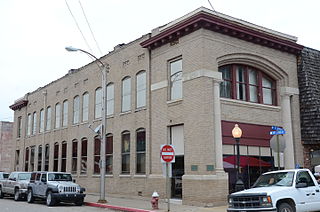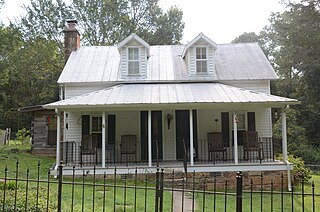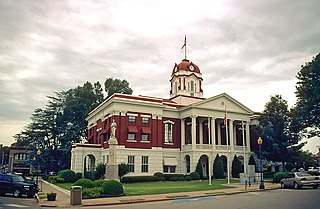
This is a list of the National Register of Historic Places listings in Tuscaloosa County, Alabama.

U.S. Route 64 is a U.S. highway running from Teec Nos Pos, Arizona east to Nags Head, North Carolina. In the U.S. state of Arkansas, the route runs 246.35 miles (396.46 km) from the Oklahoma border in Fort Smith east to the Tennessee border in Memphis. The route passes through several cities and towns, including Fort Smith, Clarksville, Russellville, Conway, Searcy, and West Memphis. US 64 runs parallel to Interstate 40 until Conway, when I-40 takes a more southerly route.

This is a list of the National Register of Historic Places listings in Searcy County, Arkansas.

Smyrna Methodist Church is a historic church in rural White County, Arkansas. It is located west of Searcy, on Jaybird Lane just south of Arkansas Highway 36. It is a single story wood frame structure, with a gabled roof, mainly weatherboard siding, and a stone foundation. A small open belfry rises from the roof ridge, topped by a gabled roof. The front facade has a projecting gabled vestibule, its gabled section finished in diamond-cut wooden shingles. The main gable is partly finished in vertical board siding, with decorative vergeboard woodwork attached to the roof edge. Built in 1854, it is one of the county's few surviving pre-Civil War buildings, and its finest surviving Greek Revival church. Some of the logs used to build the church began growing as trees in the early 1600s.

The Arnold Farmstead was a historic farmstead near McRae and Maple Streets in Searcy, Arkansas. The farmstead included a Craftsman-style main house and a collection of outbuildings consisting of a chicken coop, privy, well house, and fruit cellar. The house was a 1 1⁄2-story wood-frame structure that was roughly T-shaped with additions. The south-facing front was sheltered by a full-width porch, which wrapped around the west side. Although suburban residences have encroached on its formerly rural setting, the complex of buildings, dating to the 1920s, was remarkably well-preserved.

The Bank of Searcy is a historic bank building at 301 North Spruce Street in downtown Searcy, Arkansas. It is a two-story buff brick structure, whose main entrance is flanked by Doric columns supporting a segmented arch. The building has other vernacular elements of the Classical Revival, including segmented-arch window bays on the facade facing Arch Avenue. It was built in 1906, following a fire that destroyed many of the commercial buildings on the west side of the courthouse, which stands across North Spruce Street.

The Campbell Post Office–Kuykendall General Store is a historic residential–commercial building in rural Searcy County, Arkansas. It is located on County Road 73, northwest of Oxley, Arkansas. It is a single-story wood frame structure with modest Greek Revival styling. Its construction date was long thought to be 1920, but it was more likely built around 1900, still an extremely late date for the Greek Revival. It was converted into a post office and general store in the 1920s by Henry Kuykendall.
The Franklin Desha House is a historic house in Desha, Arkansas. It is a single-story double-pen dogtrot house, with a side gable roof and a projecting gabled roof at the center of its main facade. Built in 1861, the house is important for as one of the older houses in Independence County, and for its association with the Desha and Searcy families, both important to the history of Arkansas. Franklin Desha was the son of Robert Desha, who settled Helena, and nephew of Benjamin Desha, for whom Desha County is named. He married Elizabeth Searcy, the daughter of Richard Searcy, a lawyer and judge for whom Searcy and Searcy County are named. Desha, a veteran of the Mexican–American War, built this house in 1861, and served in the Confederate Army during the American Civil War. This property was the site of a Confederate encampment in 1863.

The Gates-Helm Farm is a historic early homestead property in rural Searcy County, Arkansas. It is located on both sides of County Road 13, north of Snowball. The property includes a single-pen log house, and a single-pen log barn, both built c. 1870, and a wood frame double-pen house built around 1900. The log structures, located down a lane on the west side of the road, were built by Peter Gates not long after purchasing the land. The house, on the east side of the road, was built by William Helm, who had married one of Gates' daughters. The property exemplifies the evolution of vernacular architecture of the period.

The William P. and Rosa Lee Martin Farm is a historic farm property in rural Searcy County, Arkansas. It contains all but two of the original buildings of a farmstead established in 1922, representing a remarkably complete collection of outbuildings in addition to the main house. Located on County Road 73, just south of Arkansas Highway 74 in the eastern part of the county, it includes the house, a barn, garage, workshop, potato house, corn crib, and wellhouse, all of which were built by the Martins, who worked a 200-acre (81 ha) farm until their deaths in 1971. The buildings have seen generally minor alterations and improvements, a rarity in rural Arkansas where farmsteads of this vintage are often abandoned and demolished.

The Old Searcy County Jail is a historic building on Center Street, on the south side of the courthouse square in Marshall, Arkansas. It is a two-story stone structure, built out of local sandstone, with a pyramidal roof topped by a cupola. The front facade, three bays wide, has a central bay that projects slightly, rising to a gabled top, with barred windows at each level. The main entrance is recessed in the rightmost bay. The building's interior houses jailer's quarters on the ground floor and cells on the upper level. Built in 1902, it was used as a jail until 1976, and briefly as a museum thereafter.

The St. Joe Missouri and North Arkansas Railroad Depot is a historic railroad station on the south side of United States Route 65 in the center of St. Joe, Arkansas. It is a typical long rectangular building, with a gable-on-hip roof, and a telegrapher's booth projecting out the north side. Built in about 1912 by the Missouri and North Arkansas Railroad, it is the only one of that railroad's wood-frame depots to survive in the state, and is the only railroad depot in Searcy County in its original location. The town of St. Joe was incorporated in 1902 as a railroad town.

The Searcy County Courthouse is located on Courthouse Square in Marshall, Arkansas. It is a two-story stone structure, with a hip roof. The walls are fashioned out of rustically cut native sandstone, and it is topped by a metal hip roof with widely overhanging eaves. The front entrance is sheltered by a single-story porch supported by cast stone columns. The courthouse, the third for Searcy since its incorporation in 1838, was built in 1889 on the site of the second courthouse, which was destroyed by fire. The first courthouse was in Lebanon, about 6 miles (9.7 km) to the west, before being moved to Marshall in 1855.

The Willmering Tourist Cabins Historic District encompasses a historic tourist accommodation on United States Route 65 in central northern Searcy County, Arkansas, just south of the Buffalo National River. Located behind the Silver Hill Float Service on the west side of the highway stand six stone and timber cabins, with large standstone blocks and plank doors on the fronts, and shed roofs obscured by parapets. Built in 1946 by Harry Willmering, these vernacular structures are representative of tourist accommodations built in the period after World War II to cater to the automobile-based vacationing public.

The Jasper E. Treece Building is a historic farm outbuilding in rural eastern Searcy County, Arkansas. It is located on the west side of County Road 55, about 0.5 miles (0.80 km) south of its junction with Arkansas Highway 74. It is a modest single-story stone structure, with a corrugated metal gable roof. The only openings in its walls are the doorway in the eastern facade, which has a wooden plank door, and a small opening on the north side. The walls are eighteen inches thick. The building was built in 1898 for Jasper Treece by the Cypert brothers, local stonemasons, and was intended for use as a storage facility for non-perishable items, with granary space in the attic. It is of unusually high quality for a typically utilitarian structure.

The Cottage Courts Historic District encompasses a historic travelers' accommodation at 609 Park Avenue in Hot Springs, Arkansas. Built about 1950, it was one of the first motel-type tourist accommodations to be built in the city. Unlike earlier tourist courts, which typically had idiosyncratic vernacular architecture, Cottage Courts consists of two ranch-style single-story buildings, one of which houses twelve guest rooms, and the other three plus the operator's apartment and office.

The Parkway Courts Historic District encompasses a historic tourist accommodation at 815 Park Avenue in Hot Springs, Arkansas. It is a U-shaped tourist court, with 48 units and a building housing an office and manager's residence. The units come in three styles, some with larger sleeping and living spaces, and some with kitchenettes. Each unit is highlighted architecturally by a steeply pitched gable over the entrance. The buildings are brick. The units were built in 1943, and the manager's residence/office in 1950, after the original burned down. It is one of the city's oldest surviving tourist courts.

The Perry Plaza Court Historic District encompasses a historic tourist accommodation at 1007 Park Avenue in Hot Springs, Arkansas. It consists of a long two-story brick building in the International style, along with a small office building and swimming pool. It houses 19 single-bedroom units, which are now rented as apartments. Built in 1947–48, it is a fine example of the International Style. The unit interiors retain a number of period features, including tile and plumbing fixtures.

The Searcy Municipal Courthouse, formerly the Searcy Post Office is a historic government building at Gum and Arch Streets in downtown Searcy, Arkansas. It is a two-story brick building with Renaissance Revival styling. The central bays of its main facade are articulated by paneled pilasters of the Corinthian order, with large two-story windows flanking a two-story entrance, all set in recessed segmented-arch openings. The shallow hipped roof has elongated eaves with large brackets. The building was designed by Oscar Wenderoth and built in 1914, and is the only high-style Renaissance Revival building in White County.

The White County Courthouse is located at Court Square in the center of Searcy, Arkansas, the county seat of White County. It is a two-story structure, built out of stone and brick, with a hip roof capped by an elaborate cupola with clock faces in its bowed roof. The building is roughly H shaped, with wings at the sides that project slightly to the front and rear. The ground floor is faced in dressed stone, while the upper floor is finished in brick. Entrance is made through an arcade of rounded arches, which support a Greek pedimented temple projection that has four fluted Corinthian columns. The courthouse was built in 1871 and enlarged by the addition of the wings in 1912. In addition, repairs were conducted by the Civil Works Administration in 1933.




















